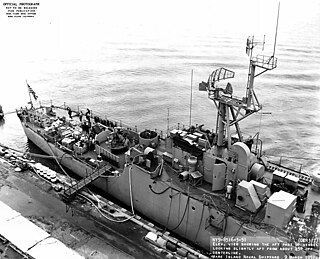
USS Du Pont (DD–152) was a Wickes-class destroyer in the United States Navy during World War II, later reclassified as AG-80. She was the second ship named for Rear Admiral Samuel Francis Du Pont.

The third USS Decatur (DD-341) was a Clemson-class destroyer in the United States Navy following World War I. She was named for Stephen Decatur.

USS Hyman (DD-732), was an Allen M. Sumner-class destroyer of the United States Navy.

USS Thaddeus Parker (DE-369) was a John C. Butler-class destroyer escort in service with the United States Navy from 1944 to 1946 and from 1951 to 1967. She was scrapped in 1968.

USS Huse (DE-145) was a U.S. Navy destroyer escort launched by Consolidated Steel Corp., Orange, Texas on 23 March 1943, during World War II. The ship was sponsored by Mrs. L. M. Humrichouse, daughter of Admiral Harry McLaren Pinckney Huse, whom the ship was named after and commissioned on 30 August 1943.

USS Andres (DE-45) was an Evarts-class destroyer escort constructed for the United States Navy during World War II. Sent off to the dangerous waters of the North Atlantic Ocean during the Battle of the Atlantic to protect convoys and other ships from Nazi Germany's Kriegsmarine U-boats and fighter aircraft, Andres performed escort and anti-submarine operations.

USS Jacob Jones (DE-130) was an Edsall-class destroyer escort built for the U.S. Navy during World War II. She served in the Atlantic Ocean and provided destroyer escort service against submarine and air attack for Navy vessels and convoys.

USS Tomich (DE-242) was an Edsall-class destroyer escort in service with the United States Navy from 1943 to 1946. She was scrapped in 1974.

USS J. Richard Ward (DE-243) was an Edsall-class destroyer escort built for the U.S. Navy during World War II. She served in the Atlantic Ocean the Pacific Ocean and provided destroyer escort protection against submarine and air attack for Navy vessels and convoys. She was named in honor of James Richard Ward who was awarded the Medal of Honor posthumously for his heroic efforts under fire on the USS Oklahoma (BB-37). She was launched by Brown Shipbuilding Co., Houston, Texas, 6 January 1943; sponsored by Miss Marjorie Ward, sister of Seaman First Class Ward; and commissioned 5 July 1943.

USS Snowden (DE-246) was an Edsall-class destroyer escort built for the U.S. Navy during World War II. She served in the Atlantic Ocean the Pacific Ocean and provided destroyer escort protection against submarine and air attack for Navy vessels and convoys.

USS Sellstrom (DE-255) was an Edsall-class destroyer escort built for the U.S. Navy during World War II. She served in the Atlantic Ocean, the Pacific Ocean and provided destroyer escort protection against submarine and air attack for Navy vessels and convoys.

USS Harveson (DE-316) was an Edsall-class destroyer escort built for the U.S. Navy during World War II. She served in the Atlantic Ocean the Pacific Ocean and provided destroyer escort protection against submarine and air attack for Navy vessels and convoys.

USS Joyce (DE-317) was originally commissioned as a US Coast Guard Edsall-class destroyer escort built for the U.S. Navy during World War II. She served in the Atlantic Ocean and the Pacific Ocean and provided destroyer escort protection against submarine and air attack for Navy vessels and convoys. During its World War II service, on two different engagements with enemy submarines, the Joyce rescued survivors of the tanker SS Pan- Pennsylvania and its sister ship USS Leopold. Joyce received one battle star for its service during World War II.

USS Merrill (DE-392) was an Edsall-class destroyer escort in service with the United States Navy from 1943 to 1946. She was sold for scrapping in 1974.

USS Janssen (DE-396) was an Edsall-class destroyer escort in service with the United States Navy from 1943 to 1946. She was sold for scrapping in 1973.

USS Maurice J. Manuel (DE-351) was a John C. Butler-class destroyer escort acquired by the U.S. Navy during World War II. The primary purpose of the destroyer escort was to escort and protect ships in convoy, in addition to other tasks as assigned, such as patrol or radar picket.

USS Tweedy (DE-532) was a John C. Butler-class destroyer escort in service with the United States Navy from 1944 to 1946 and from 1952 to 1969. She was sunk as a target in 1970.

USS Hollis (DE-794/APD-86) was a Buckley-class destroyer escort in service with the United States Navy from 1944 to 1947 and from 1951 to 1956. She was scrapped in 1975.

USS Greenwood (DE-679) was a Buckley-class destroyer escort in service with the United States Navy from 1943 to 1962. She was scrapped in 1968.

USS Loeser was a Buckley-class destroyer escort of the United States Navy, named in honor of Lieutenant Commander Arthur E. Loeser (1903–1942).




















